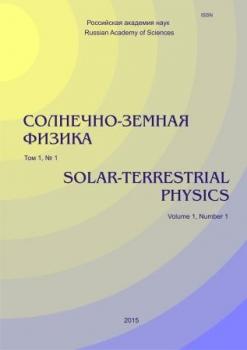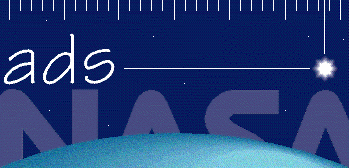Иркутск, Россия
Иркутск, Россия
Показано, что граница обращения ионосферной конвекции является фундаментальным параметром магнитосферно-ионосферной связи, определяющим сильную аналогию между электростатическим потенциалом ионосферы и эквивалентной токовой функцией в приближении дипольного геомагнитного поля и однородной проводимости ионосферы. Разработан новый наземный метод автоматической диагностики границ аврорального овала по выходным данным техники инверсии магнитограмм (ТИМ). На основе карт распределений токовой функции и продольных токов, рассчитанных на первом этапе ТИМ при однородной проводимости ионосферы, определяются граница обращения ионосферной конвекции, граница полярной шапки, экваториальная граница аврорального овала и линия максимумов плотности авроральных электроструй. Указанные параметры ранее определялись визуально-ручным методом: анализом карт продольных и эквивалентных токов на экране монитора и проведением заданных границ с помощью мыши, что занимало очень много времени (недели и месяцы). Сравнение границ, полученных старым ручным и новым автоматическим методами, показало, что коэффициент корреляции между двумя границами составляет в среднем 0.85, а среднеквадратичное отклонение не превышает 2° по широте. Обеспечивая достаточную точность определения границ, автоматический метод сокращает время обработки необходимых объемов данных на два-три порядка (до минут и часов), освобождая исследователя от трудоемкой визуальной работы. Новый метод реализован как один из важных блоков модернизированного комплекса программ ТИМ.
ионосферная конвекция, эквивалентная токовая функция, авроральный овал, полярная шапка, продольные токи, граница обращения конвекции
1. Базаржапов А.Д., Матвеев М.И., Мишин В.М. Геомагнитные вариации и бури. Новосибирск. Наука, 1979. 248 с.
2. Лазутин Л.Л. Овал полярных сияний - прекрасная, но устаревшая парадигма // Солнечно-земная физика. 2015. Т. 1, № 1, С. 23-35. DOI:https://doi.org/10.12737/5673.
3. Матвеев М.И., Шпынев Г.Б. Определение электрических полей и продольных токов в магнитосфере по данным геомагнитных возмущений (высокоширотная область) // Исследования по геомагнетизму, аэрономии и физике Солнца. 1975. Вып. 36. С. 34-39.
4. Мишин В.М., Шпынев Г.Б., Базаржапов А.Д., Шира-пов Д.Ш. Электрическое поле и токи в неоднородно-проводящей высокоширотной ионосфере // Исследования по геомагнетизму, аэрономии и физике Солнца. 1981. Вып. 53. С. 116-133.
5. Ширапов Д.Ш., Мишин В.М., Базаржапов А.Д., Сайфудинова Т.И. Адаптированная динамическая модель проводимости ионосферы // Геомагнетизм и аэрономия. 2000. Т. 40, № 4. С. 471-475.
6. Akasofu S.I. Polar and Magnetospheric Substorms. Dordrecht, Holland, Springer Netherlands, 1968. 280 p. DOI:https://doi.org/10.1007/978-94-010-3461-6.
7. Akasofu S.I. Physics of Magnetospheric Substorms. Dordrecht, Holland, Springer Netherlands, 1977. 617 p. DOI:https://doi.org/10.1007/978-94-010-1164-8_1.
8. Alfvén H. Cosmic plasma. Dordrecht, Holland, Springer Netherlands, 1981, 168 p. DOI:https://doi.org/10.1007/978-94-009-8374-8.
9. Axford W.I., Hines C.O. A Unifying Theory of High-Latitude Geophysical Phenomena and Geomagnetic Storms // Can. J. Phys. 1961. V. 39, N 10. P. 1433-1464. DOI:https://doi.org/10.1139/p61-172.
10. Baker D.N., Peterson W.K., Eriksson S., et al. Timing of magnetic reconnection initiation during a global magnetospheric substorm onset // Geophys. Res. Lett. 2002. V. 29, N 24. P. 2190. DOI:https://doi.org/10.1029/2002GL015539.
11. Bazarzhapov A.D., Mishin V.M., Shpynev G.B. A Mathe-matical Analysis of Geomagnetic Variation Fields // Gerlands Beitr. Geophys. 1976. V. 85, N 1. P. 76-82.
12. Boakes P.D., Milan S.E., Abel G.A., et al. On the use of IMAGE FUV for estimating the latitude of the open/closed magnetic field line boundary in the ionosphere // Ann. Geophys. 2008. V 26, N 9. P. 2759-2769. DOI:https://doi.org/10.5194/angeo-26-2759-2008.
13. Boström R. Ionosphere-magnetosphere coupling // Magnetospheric Physics. Ed. by B.M. McCormac. D. Reidel Publishing Company, Dordrecht-Holland, 1974. P. 45-59.
14. Bristow W.A., Spaleta J. An investigation of the characteristics of the convection reversal boundary under southward interplanetary magnetic field // J. Geophys. Res.: Space Phys. 2013. V. 118, N 10. P. 6338-6351. DOI: 10.1002/ jgra.50526.
15. Chapman S., Bartels J. Geomagnetism. V. 2. Great Britain, Oxford University Press, 1940. 520 p.
16. Chen Y.J., Heelis R.A., Cumnock J.A. Response of the ionospheric convection reversal boundary at high latitudes to changes in the interplanetary magnetic field // J. Geophys. Res.: Space Phys. 2015. V. 120, N 6. P. 5022-5034. DOI:https://doi.org/10.1002/2015ja021024.
17. Drake K.A., Heelis R.A., Hairston M.R., Anderson P.C. Electrostatic potential drop across the ionospheric signature of the low-latitude boundary layer // J. Geophys. Res. 2009. V. 114, N A4. DOI:https://doi.org/10.1029/2008ja013608.
18. Dungey J.W. Interplanetary magnetic field and the auroral zones // Phys. Rev. Lett. 1961. V. 6, N 2. P. 47-48. DOI:https://doi.org/10.1103/PhysRevLett.6.47.
19. Feldstein Y.I. Polar auroras, polar substorms, and their relationships with the dynamics of the magnetosphere // Rev. Geophys. 1969. V. 7, N 1-2. P. 179-218. DOI:https://doi.org/10.1029/RG007 i001p00179.
20. Feldstein Y.I. The discovery and the first studies of the auroral oval: A review // Geomagnetism and Aeronomy.2016. V. 56, N 2. P. 129-142. DOI:https://doi.org/10.1134/s0016793216020043.
21. Feldstein Y.I., Starkov G.V. Dynamics of auroral belt and polar geomagnetic disturbances // Planet. Space Sci. 1967. V. 15, N 2. P. 209-229. DOI:https://doi.org/10.1016/0032-0633(67)90190-0.
22. Fukushima N. Generalized theorem for no ground magnetic effect of vertical currents connected with Pedersen currents in the uniform-conductivity ionosphere // Report of Ionosphere and Space Research in Japan. 1976. V. 30, N 1-2. P. 35-40.
23. Gjerloev J.W. The SuperMAG data processing technique // J. Geophys. Res. 2012. V. 117, N A9. P. A09213. DOI: 10.1029/ 2012ja017683.
24. Gussenhoven M.S., Hardy D.A., Heinemann N. Systematics of the equatorward diffuse auroral boundary // J. Geophys. Res. 1983. V. 88, N A7. P. 5692-5708. DOI:https://doi.org/10.1029/JA088iA07 p05692.
25. Haaland S., Lybekk B., Maes L., et al. North-south asymmetries in cold plasma density in the magnetotail lobes: Cluster observations // J. Geophys. Res.: Space Phys. 2017. V. 122, N 1. P. 136-149. DOI:https://doi.org/10.1002/2016ja023404.
26. Haines G.V., Torta J.M. Determination of equivalent current sources from spherical cap harmonic models of geomagnetic field variations // Geophys. J. Int. 1994. V. 118, N 3. P. 499-514. DOI:https://doi.org/10.1111/j.1365-246X.1994.tb03981.x.
27. Harang L. The mean field of disturbance of polar geomagnetic storms // Terr. Magn. Atmos. Electr. 1946. V. 51, N 3. P. 353-380. DOI:https://doi.org/10.1029/TE051i003p00353.
28. Heikkila W.J. Earth’s Magnetosphere: Formed by the Low-Latitude Boundary Layer. Amsterdam, Elsevier Science, 2011. 536 p. DOI:https://doi.org/10.1016/B978-0-444-52864-3.10012-7.
29. Heppner J.P. Electric field variations during substorms: OGO-6 measurements // Planet. Space Sci. 1972. V. 20, N 9. P. 1475-1498. DOI:https://doi.org/10.1016/0032-0633(72)90052-9.
30. Hubert B., Aikio A.T., Amm O., et al. Comparison of the open-closed field line boundary location inferred using IMAGE-FUV SI12 images and EISCAT radar observations // Ann. Geophys. 2010. V. 28, N 4. P. 883-892. DOI:https://doi.org/10.5194/angeo-28-883-2010.
31. Iijima T., Potemra T.A. Large-scale characteristics of field-aligned currents associated with substorms // J. Geophys. Res. 1978. V. 83, N A2. P. 599-615. DOI:https://doi.org/10.1029/JA083iA02p 00599.
32. Kamide Y., Matsushita S. Simulation studies of ionospheric electric fields and currents in relation to field-aligned currents. 1. Quiet periods // J. Geophys. Res. 1979. V. 84, N A8. P. 4083-4098. DOI:https://doi.org/10.1029/JA084iA08p04083.
33. Kamide Y., Richmond A.D. Ionospheric conductivity dependence of electric fields and currents estimated from ground magnetic observations // J. Geophys. Res. 1982. V. 87, N A10. P. 8331-8337. DOI:https://doi.org/10.1029/JA087iA10p08331.
34. Kamide Y., Baumjohann W. Magnetosphere-ionosphere coupling. Berlin, Springer Berlin Heidelberg, 1993. 178 p. DOI:https://doi.org/10.1007/978-3-642-50062-6.
35. Kern J.W. Analysis of Polar Magnetic Storms // J. Geomag. Geoelectr. 1966. V. 18, N 2. P. 125-131. DOI:https://doi.org/10.5636/jgg.18.125.
36. Koustov A.V., Fiori R.A.D. Seasonal and solar cycle variations in the ionospheric convection reversal boundary location inferred from monthly SuperDARN data sets // Ann. Geophys. 2016. V. 34, N 2. P. 227-239. DOI:https://doi.org/10.5194/angeo-34-227-2016.
37. Laundal K.M., Haaland S.E., Lehtinen N., et al. Birkeland current effects on high-latitude ground magnetic field perturbations // Geophys. Res. Lett. 2015. V. 42, N 18. P. 7248-7254. DOI:https://doi.org/10.1002/2015gl065776.
38. Longden N., Chisham G., Freeman M.P., et al. Estimating the location of the open-closed magnetic field line boundary from auroral images // Ann. Geophys. 2010. V. 28, N 9. P. 1659-1678. DOI:https://doi.org/10.5194/angeo-28-1659-2010.
39. Makita K., Meng C.I., Akasofu S.I. The shift of the auroral electron precipitation boundaries in the dawn-dusk sector in association with geomagnetic activity and interplanetary magnetic field // J. Geophys. Res. 1983. V. 88, N A10. P. 7967-7981. DOI:https://doi.org/10.1029/JA088iA10p07967.
40. Makita K., Meng C.I., Akasofu S.I. Temporal and spatial variations of the polar cap dimension inferred from the precipitation boundaries // J. Geophys. Res. 1985. V. 90, N A3. P. 2744-2752. DOI:https://doi.org/10.1029/JA090iA03p02744.
41. Milan S.E., Provan G., Hubert B. Magnetic flux transport in the Dungey cycle: A survey of dayside and nightside reconnection rates // J. Geophys. Res. 2007. V. 112, N A1. P. A01209. DOI:https://doi.org/10.1029/2006ja011642.
42. Milan S.E., Evans T.A., Hubert B. Average auroral configuration parameterized by geomagnetic activity and solar wind conditions // Ann. Geophys. 2010. V. 28, N 4. P. 1003-1012. DOI:https://doi.org/10.5194/angeo-28-1003-2010.
43. Mishin V.M. The magnetogram inversion technique and some applications // Space Sci Rev. 1990. V. 53, N 1-2. P. 83-163. DOI:https://doi.org/10.1007/bf00217429.
44. Mishin V.M., Lunyushkin S.B., Shirapov D.S., Baumjohann W. A new method for generating instantaneous ionospheric conductivity models using ground-based magnetic data // Planet. Space Sci. 1986. V. 34, N 8. P. 713-722. DOI:https://doi.org/10.1016/0032-0633(86)90125-x.
45. Mishin V.M., Mishin V.V., Lunyushkin S.B., et al. 27 August 2001 substorm: Preonset phenomena, two main onsets, field-aligned current systems, and plasma flow channels in the ionosphere and in the magnetosphere // J. Geophys. Res.: Space Phys. 2017. V. 122, N 5. P. 4988-5007. DOI:https://doi.org/10.1002/2017 ja023915.
46. Newell P.T., Liou K., Zhang Y., et al. OVATION Prime-2013: Extension of auroral precipitation model to higher disturbance levels // Space Weather. 2014. V. 12, N 6. P. 368-379. DOI:https://doi.org/10.1002/2014sw001056.
47. Reiff P.H. Models of auroral-zone conductances // Magnetospheric Currents. Ed. by T.A. Potemra, Washington, DC, AGU, 1984. P. 180-191. DOI:https://doi.org/10.1029/GM028p0180.
48. Russell C.T., McPherron R.L. The magnetotail and substorms // Space Sci Rev. 1973. V. 15, N 2-3. P. 205-266. DOI:https://doi.org/10.1007/bf00169321.
49. Shukhtina M.A., Gordeev E.I., Sergeev V.A., et al. Magnetotail magnetic flux monitoring based on simultaneous solar wind and magnetotail observations // J. Geophys. Res.: Space Phys. 2016. V. 121, N 9. P. 8821-8839. DOI: 10.1002/ 2016ja022911.
50. Sotirelis T., Newell P.T. Boundary-oriented electron precipitation model // J. Geophys. Res. 2000. V. 105, N A8. P. 18655-18673. DOI:https://doi.org/10.1029/1999ja000269.
51. Sugiura M. A fundamental magnetosphere-ionosphere coupling mode involving field-aligned currents as deduced from DE-2 observations // Geophys. Res. Lett. 1984. V. 11, N 9. P. 877-880. DOI:https://doi.org/10.1029/GL011i009p00877.
52. Sun W., Lee L.C., Kamide Y., Akasofu S.I. An improvement of the Kamide-Richmond-Matsushita scheme for the estimation of the three-dimensional current system // J. Geophys. Res. 1985. V. 90, N A7. P. 6469-6474. DOI:https://doi.org/10.1029/JA090 iA07p06469.
53. Troshichev O.A., Shishkina E.M., Lu G., Richmond A.D. Relationship of the ionospheric convection reversal to the hard auroral precipitation boundary // J. Geophys. Res. 1996. V. 101. N A7. P. 15423-15432. DOI:https://doi.org/10.1029/96ja01192.
54. Vasyliūnas V.M. Mathematical Models of Magnetospheric Convection and its Coupling to the Ionosphere // Particles and Fields in the Magnetosphere. Ed. by B.M. McCormac, Springer Netherlands, 1970. P. 60-71. DOI:https://doi.org/10.1007/978-94-010-3284-1_6.
55. Vorobjev V.G., Yagodkina O.I., Katkalov Y.V. Auroral Precipitation Model and its applications to ionospheric and magnetospheric studies // J. Atmos. Solar. Terr. Phys. 2013. V. 102, P. 157-171. DOI:https://doi.org/10.1016/j.jastp.2013.05.007.
56. Winningham J.D., Heikkila W.J. Polar cap auroral electron fluxes observed with Isis 1 // J. Geophys. Res. 1974. V. 79, N 7. P. 949-957. DOI:https://doi.org/10.1029/JA079i007p00949.
57. URL: http://supermag.jhuapl.edu (дата обращения 2 июня 2018).
58. URL: http://vt.superdarn.org/tiki-index.php (дата обращения 2 июня 2018).


















